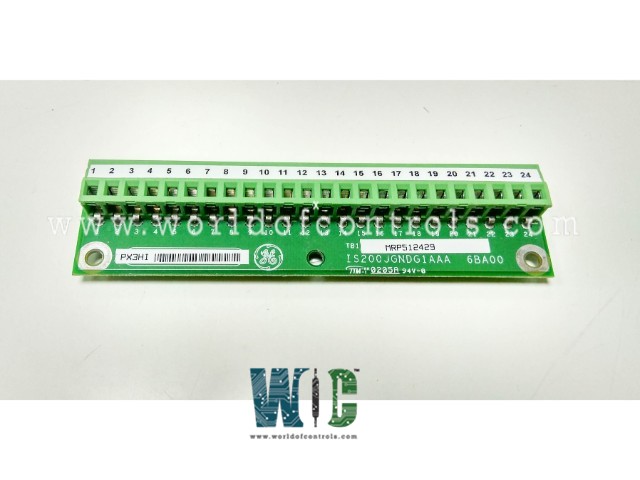SPECIFICATIONS
Part No.: IS200JGNDG1A
Manufacturer: General Electric
Country of Manufacture: United States of America (USA)
Terminals: 24
Temperature: -30 to +65oC
Size: 3.175 cm high x 12.7 cm wide
Mounting: Held with three screws
Product Type: Shield Ground Terminal Board
Availability: In Stock
Series: Mark VIe
Functional Description
IS200JGNDG1A is a Shield Ground Terminal Board developed by GE. It is a part of Mark VIe control system. The Shield Ground (JGND) terminal board is designed to facilitate the grounding of shield drain wires in customer installations. The Shield Ground (JGND) terminal board is strategically positioned alongside the primary terminal board within the system enclosure. This placement ensures accessibility and seamless integration, allowing for convenient grounding of shield drain wires.
Features
- Grounding for Shield Drain Wires: The primary function of the Shield Ground terminal board is to provide dedicated ground connections for the shield drain wires of customer-installed cables. Shield drain wires play a critical role in dissipating electromagnetic interference (EMI) and maintaining signal integrity. The terminal board ensures optimal performance and reliability of shielded cables by offering secure grounding points.
- Convenient Connectivity: Equipped with multiple ground connection points, the terminal board facilitates easy termination of shield drain wires. Its design accommodates various cable configurations, allowing for flexible connectivity options to meet specific installation requirements.
- Enhanced System Reliability: Proper grounding of shielded cables is essential for minimizing noise and ensuring reliable operation of sensitive electronic equipment. The JGND terminal board contributes to overall system reliability by providing a robust and convenient solution for grounding shield drain wires, thereby mitigating the risk of EMI-induced signal degradation or interference.
- Simplified Installation and Maintenance: With its user-friendly design and straightforward installation process, the terminal board streamlines system setup and maintenance tasks. Installers can quickly connect shield drain wires to the designated ground terminals, reducing installation time and complexity. Maintenance personnel can easily access and inspect the grounding connections as needed, facilitating troubleshooting and ensuring ongoing system performance.
Installation
- Mounting Configuration: The terminal board mounts on a sheet metal bracket attached to the plate holding the primary terminal board. This arrangement ensures stability and structural integrity, with securely anchored alongside the terminal board. The bracket is grounded to the sheet metal using two screws at each end of the terminal board, establishing a reliable electrical connection.
- Grounding Mechanism: Grounding of the terminal board is facilitated through the sheet metal bracket. This provides a robust pathway for grounding, ensuring effective dissipation of electrical currents and minimizing the risk of interference or signal degradation. The grounding connection is essential for maintaining signal integrity and system reliability.
- Shield Wire Connections: Customer's shield wires are connected to terminals in the Euro-type terminal block on the board. This terminal block offers a convenient and secure interface for terminating shield drain wires, allowing for efficient grounding within the system.
- Scalability and Flexibility: Depending on system requirements, one or two boards can be located on the side of the terminal board mounting bracket, providing a maximum of 48 ground connections. This scalability allows for expansion and customization to accommodate varying installation needs and configurations.
- Mechanical Assembly: The default mechanical assembly of the board includes a nylon washer between the board and the sheet metal bracket. This isolates JGND from the sheet metal, providing flexibility in grounding options. Removal of the washer permits direct conduction of ground currents into the local sheet metal, eliminating the need for additional grounding leads.
- Grounding Choice: During installation, a choice must be made regarding the conduction of ground currents. This involves deciding whether to route ground currents through a wire to a designated ground (washer present) or to conduct directly to the sheet metal (washer absent). A direct connection to the sheet metal is preferred for optimal grounding performance. If a wire connection is used, it should be kept as short as possible, not exceeding 5 cm (2 in), to minimize resistance and ensure effective grounding.
The WOC team is always available to help you with your Mark VIe requirements. For more information, please contact WOC.
Frequently Asked Questions
What is IS200JGNDG1A?
It is a Shield Ground Terminal Board developed by GE under the Mark VIe series.
Why is the isolation of the terminal board from the sheet metal important?
Isolating the board from the sheet metal prevents unintended grounding connections and ensures that ground currents are directed as intended. This helps maintain system integrity and reliability.
What happens when the nylon washer is removed from the board assembly?
Removal of the nylon washer permits direct conduction of ground currents into the local sheet metal. This eliminates the need for additional grounding leads and simplifies the grounding process.
Are there any limitations to removing the nylon washer from the board?
While removing the nylon washer allows for direct conduction of ground currents into the local sheet metal, it's important to ensure that the sheet metal provides a suitable grounding path. Additionally, proper precautions should be taken to avoid unintended grounding connections and ensure system safety.
